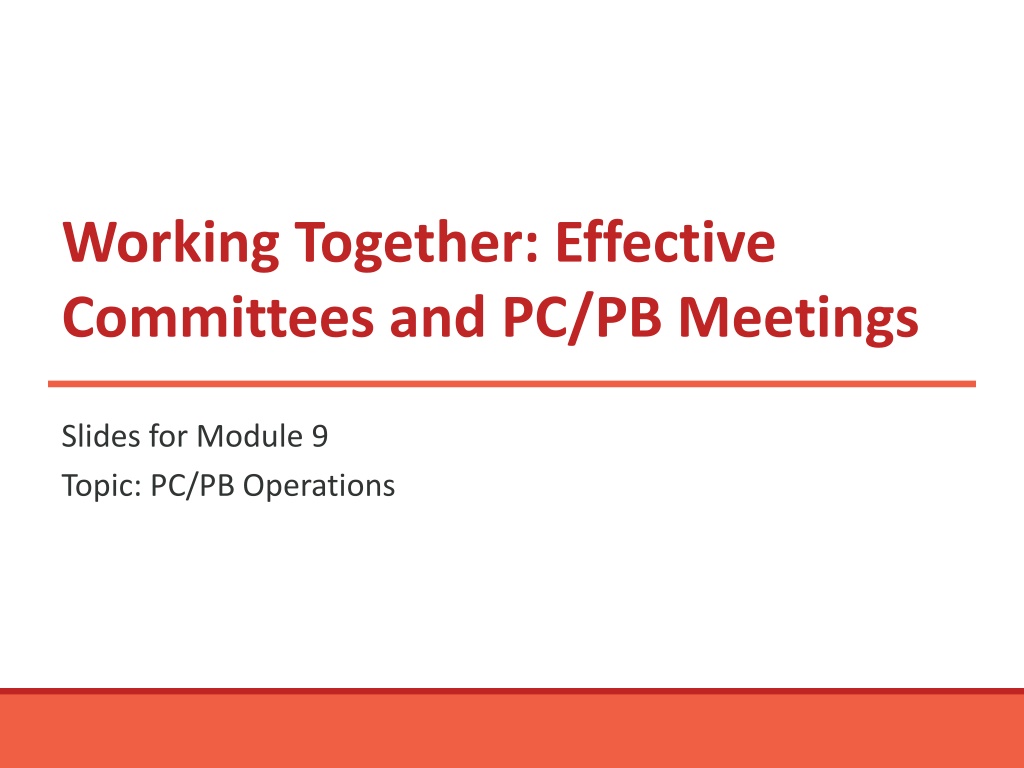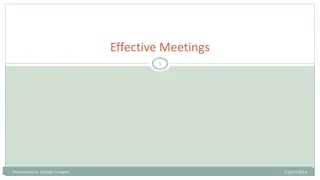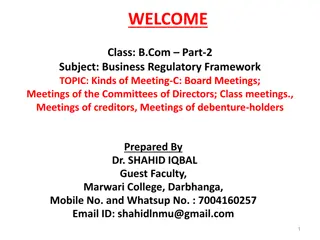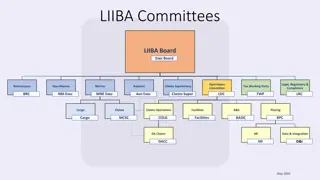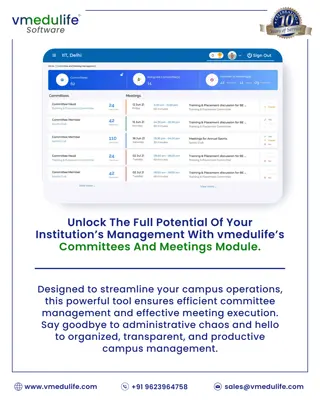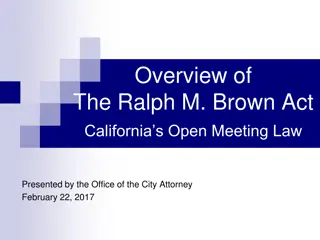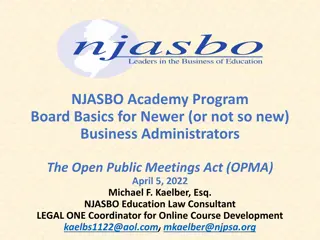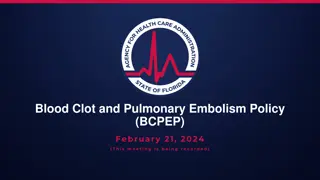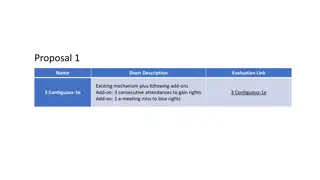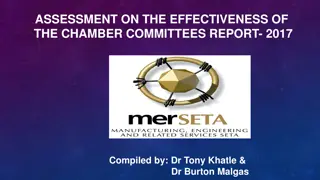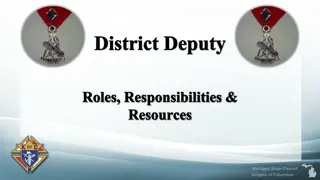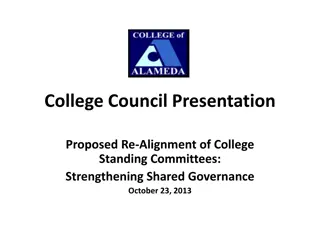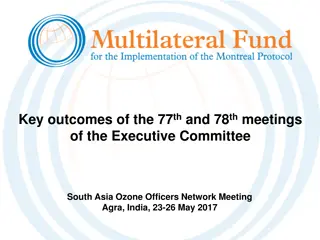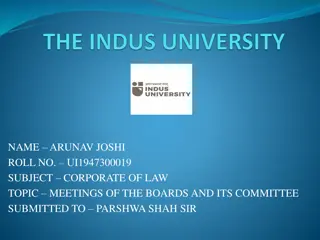Effective PC/PB Operations for Successful Committees and Meetings
Understanding the importance of operations within PC/PB committees is crucial for fulfilling legislative responsibilities efficiently. This training module covers key objectives such as committee structures, factors to consider in committee structuring, characteristics of successful meetings, managing committees without ample support, and the role of the Chair in meeting success. The scope of PC/PB operations, HRSA/HAB expectations, and the significance of efficient operations are detailed to enhance committee effectiveness.
Download Presentation

Please find below an Image/Link to download the presentation.
The content on the website is provided AS IS for your information and personal use only. It may not be sold, licensed, or shared on other websites without obtaining consent from the author. Download presentation by click this link. If you encounter any issues during the download, it is possible that the publisher has removed the file from their server.
E N D
Presentation Transcript
Working Together: Effective Committees and PC/PB Meetings Slides for Module 9 Topic: PC/PB Operations
PC/PB Operations Importance of Operations Working Effectively in Committees Successful PC/PB meetings
Training Objectives Following the training, participants will be able to: 1. Explain how PC/PB operations affect the PC/PB s ability to meet legislative responsibilities 2. Identify the 2 main types of PC/PB committees 3. Describe at least 4 factors to consider in structuring or rethinking PC/PB committees 4. Describe 5 characteristics of a successful PC/PB or committee meeting 5. Identify at least 3 ways to manage committees successfully in a PC/PB with limited support staff 6. Identify at least 5 ways in which the Chair can help make PC/PB meetings successful
Importance of Operations PC/PBs have legislatively defined tasks that must be completed on time each year Work of committees needs to be coordinated sometimes one committee must complete its task before another committee can do its work For example: Needs Assessment data must be available before the PSRA process can be carried out Resources available for PC/PB planning are limited Efficient operations committee structure, staffing, implementation of Bylaws and policies & procedures make it possible for a PC/PB to meet its responsibilities
Scope of PC/PB Operations PC/PBs have many legislatively-defined responsibilities. In order to respond to these important responsibilities, the planning council (and its staff) must carry out many complex tasks to ensure smooth and fair operations and processes in such areas as bylaws, grievance procedures, conduct of public meetings, member recruitment, and training. Part A Manual, p 94
HRSA/HAB Expectations for PC/PB Operations Bylaws that are regularly reviewed, updated, and consistently followed Policies and procedures that meet RWHAP requirements and are consistently followed Open meetings with public notice, a public comment period, and materials and minutes available to the public Appropriate committees with regular meetings, agendas, and minutes PC/PB and Committee Chairs or Co-Chairs with clearly defined roles and appropriate training and support Support staff and budget to support PC/PB operations
Responsibility for PC/PB Operations Ultimate responsibility: Chair/Co-Chairs and Executive Committee Sometimes delegated or partly delegated: Membership/Operations Committee Bylaws/Policies and Procedures Committee or Work Group Non-governance aspects of operations usually carried out largely by PC/PB support staff Under the direction of the Chair or Executive Committee
Quick Scenario A: PC/PB Operations Your Executive Committee has always dealt with PC/PB operations. It forms temporary work groups for tasks like Bylaws or Policies review. It has been 3 years since the last Bylaws update, and members of the last work group have all left the PC/PB. The Chair is newly elected, and the long-time PC/PB support manager just retired. Your PC/PB requires only limited notes from work groups, and no one remembers how the process was handled last time. Should the PC/PB consider a different approach to Operations? If so, what would you recommend? Why?
Importance of Committees Assigned responsibility for legislative roles Do much of the work of the planning council Public input Consultation with outside experts In-depth discussion Recommendations to PC/PB through Executive Committee Members often participate more actively in committees than in full PC/PB meetings Voting members can include non-PC/PB members Training ground for potential new PC/PB members
HRSA/HAB Expectations for Committees Use a committee structure that helps the PC/PB meet all legislative responsibilities Describe committee structure and roles in new member orientation Require PLWH representation on all committees Consider having non-PC/PB members including PLWH serve on some committees Share committee minutes and other materials with all PC/PB members Provide training and support for committees
Types of Committees Governance: responsible for internal operations such as membership/open nominations, member training, Bylaws, policies & procedures, Memorandum of Understanding (MOU) with the recipient, coordination of PC/PB tasks Planning: responsible for carrying out legislatively defined responsibilities like needs assessment, integrated/comprehensive planning, priority setting and resource allocation, and assessment of the efficiency of the administrative mechanism
Factors to Consider in Choosing a Committee Structure PC/PB roles and tasks: work that must be done Chronology of tasks: same committee can take on several roles if they have different timelines Number of members and minimum desired committee size: smaller PC/PBs may need non-PC members to serve on some committees Resources including staff: each committee meeting involves logistics, staff time, and costs PC/PB culture : level of individual member involvement, work styles, recipient participation
Benefits of Committee Work Good use of member time Time is available in committees for in-depth discussion and public input PC/PB as a whole focuses on review, decision making, new information, and big-picture issues Efficient use of PC/PB resources, including support staff
PC/PB Staff Support for Committees Much of staff time is spent in supporting committee meetings Includes preparations: agenda, materials, determining attendance, staff support at meetings, logistics Also includes follow up: minutes, revised materials, recommendations to Executive Committee, sometimes follow up with recipient or others If the EMA or TGA has a small staff, support for committees can take up most of the staff s time Means lack of time for broader roles like coordination, member training, and support to actual planning tasks
Strategies for EMAs/TGAs with Limited Staff Make sure all committees are necessary. Consider mergers such as, Needs Assessment/PSRA, Membership/Operations Modify the annual calendar to space out major tasks needs assessment in fall/winter, PSRA in spring/summer Standardize key tasks to minimize logistics Have 2 officers for each committee--ask them to prepare agendas and provide a template so they can prepare minutes Consider use of a consensus model in committees to simplify the process and the minutes Develop university relationships and bring in work-study students or student interns to assist staff
Working Across Committees Committees are often closely linked one committee must complete its task before another committee can do its work; for example: Needs assessment data must be available before the PSRA process can be carried out Some tasks are jointly implemented; for example: Directives often jointly developed by committees responsible for system of care and needs assessment Membership and Consumer Committees may work together to recruit consumer members
Success Factors for Committees 1. 2. Clear, specific purpose with clear responsibilities Defined membership PC/PB members, sometimes non- members; consumers Defined annual work plan including objectives, tasks, products, timeline, and links to work of other committees Committed, informed leadership ideally Co-Chairs or Chair/Vice Chair, with 1 a consumer 5. Support data, staff support, recipient participation where needed 3. 4.
Characteristics of Effective Committee Meetings Planning and preparations by Chair and support staff Agenda and materials sent out in advance Convenient location and time Time for in-depth discussion Regular attendance in person or remote Active participation by all members encouraged by Chair Use of established procedures for managing the meeting Robert s Rules of Order or another model Opportunities for community input to deliberations Access to recipient staff expertise when needed
Quick Scenario B: Committee Meetings Your PC/PB requires members to serve on at least one committee, but doesn t closely enforce attendance. The EMA/TGA is geographically large, and members are allowed to participate in committee meetings by telephone. Several committee Co-Chairs have reported that only they and the assigned staff actually come in person. People connecting remotely seem to be doing other things rather than focusing on the discussion, and often join late or leave early. Two committee Co-Chairs say they will not be able to complete their required tasks this program year unless something changes. What steps might your PC/PB take to address this situation?
HRSA/HAB Expectations for PC/PB Meetings Open meetings with public notice Conflicts of interest declared and managed Use of parliamentary procedures as stated in Bylaws Public comment period Code of Conduct enforced for members and public Active participation by consumers, providers, and other members Recipient staff present PCS staff support for Chair and members
Effective Meetings Encourage discussion and decision making that are: Sound Data-based Inclusive Have members who: Participate actively Respect each other s views Feel involved and valued Choose to remain active
Characteristics of a Successful Meeting Appropriately scheduled, with publicly posted agenda Materials sent out in advance Convenient, accessible location Informed management and facilitation by the Chair Agenda that is followed Structured discussion, with most members participating Comfortable environment, with input from all members welcomed Use of established parliamentary procedures Appropriate data provided/used for decision making
Warning Signs to Recognize and Address Low attendance trouble reaching quorum High level of tension and conflict Divisions among different groups of members such as providers vs. consumers, new vs. veteran members Limited participation in discussion a few members do most of the talking; consumers do not speak out Lack of respectful listening Scheduled tasks and needed decisions not completed Time spent on topics not on the approved agenda A feeling that the PC/PB is not making a difference
Planning Successful PC/PB Meetings 1. Establish meeting goals: know what must be decided 2. Have Chair and Executive Committee set agenda Start with a standing agenda Schedule the most critical items early Specify who will present information for each topic Clearly identify action items Include time frames for each topic Be sure all needed materials are available and are sent out in advance Address logistical needs (PC/PB staff) 3. 4.
Role of the Chair in Successful Meetings 1. Recognize the importance of meetings 2. Work closely with PC/PB support staff to plan the meeting 3. Help develop and fully understand the agenda 4. Be sure needed materials are provided and when possible projected during the discussion 5. Be sure materials that might be needed for reference (such as, Bylaws, policies & procedures) are readily available
Role of the Chair in Successful Meetings (cont.) 6. Be sure meetings are open, accessible and welcoming, and provide an opportunity for public comment 7. Establish and consistently enforce a Code of Conduct for everyone present 8. Manage and facilitate the meeting set a positive, tone, maintain order, and encourage participation 9. Learn from experience ask for advice in improving meetings 10. Help ensure that minutes are completed, reviewed, approved, and posted promptly
Sample Code of Conduct for Members and the Public Treat everyone with respect Let every member or recognized guest speak, without interruptions Agree or disagree on issues do not attack individuals Help everyone understand the discussion by using plain language, avoiding abbreviations, and not assuming knowledge of past actions Follow the direction of the Chair When information is shared in confidence, maintain that confidence
Additions to the Code of Conduct for PC/PB Members Follow the decision-making process in the Bylaws Know when to be an advocate and when to be a planner Make decisions based on data, not self-interest If a proposed action or process does not follow the Bylaws or policies, politely inform the Chair Accept and support decisions made by the PC/PB, regardless of personal views Speak positively about the PC/PB and its members in public Take responsibility for both following these ground rules and helping ensure that others follow them
Responsibilities of Individual Members in Making Meetings Successful Review materials before the meeting Attend regularly and inform staff well before the meeting if you can t attend Pay attention put down your smart phone Offer input and ask questions Know when to act as an advocate for particular groups and when to plan for all PLWH in the EMA/TGA Base your support or opposition to a decision on the best available data Follow established rules and procedures
Quick Scenario C: Effective PC/PB Meetings Your PC/PB meetings begin with a public comment period. Individuals can sign up at arrival to speak for up to 3 minutes on any issue, and they often address key agenda items. Public input is not normally permitted during discussion of individual agenda items. However, several non-members have insisted on joining the discussion at recent meetings. Recently the Chair allowed input during the debate on an agenda item, and now these 2-3 people want to be recognized at every meeting. Last month, the meeting lasted 4 hours and agenda items had to be delayed. What might the PC/PB do to get meetings back on track while respecting the need for public input?
Sum Up PC/PB Operations make it possible for a PC/PB to meet its legislative responsibilities Support staff play a critical role where resources are limited, PC/PB needs clear priorities & good use of staff Much of a PC/PB s work can be done in committees if they are well-structured and well-run Meetings of both committees and the full PC/PB require careful planning, sound agendas, appropriate materials, and policies & procedures that are consistently followed The Chair plays a key role in making PC/PB meetings successful
Activity 9.1: Staff Support for Committees Work in a small group, choosing a facilitator and a recorder/reporter. Review each of the 4 situations related to committee operations and staffing, and discuss: Does the suggested approach make sense? If yes, how would you implement it? If no, what might be done instead?
